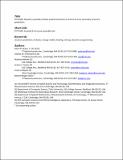STITCHER: Dynamic assembly of likely amyloid and prion beta-structures from secondary structure predictions
Author(s)
Bryan, Allen W.; O'Donnell, Charles William; Menke, Matthew E.; Cowen, Lenore J.; Lindquist, Susan; Berger Leighton, Bonnie; ... Show more Show less
Downloadmain article (667.7Kb)
OPEN_ACCESS_POLICY
Open Access Policy
Creative Commons Attribution-Noncommercial-Share Alike
Alternative title
STITCHER: Dynamic assembly of likely amyloid and prion β-structures from secondary structure predictions
Terms of use
Metadata
Show full item recordAbstract
The supersecondary structure of amyloids and prions, proteins of intense clinical and biological interest, are difficult to determine by standard experimental or computational means. In addition, significant conformational heterogeneity is known or suspected to exist in many amyloid fibrils. Previous work has demonstrated that probability-based prediction of discrete β-strand pairs can offer insight into these structures. Here, we devise a system of energetic rules that can be used to dynamically assemble these discrete β-strand pairs into complete amyloid β-structures. The STITCHER algorithm progressively ‘stitches’ strand-pairs into full β-sheets based on a novel free-energy model, incorporating experimentally observed amino-acid side-chain stacking contributions, entropic estimates, and steric restrictions for amyloidal parallel β-sheet construction. A dynamic program computes the top 50 structures and returns both the highest scoring structure and a consensus structure taken by polling this list for common discrete elements. Putative structural heterogeneity can be inferred from sequence regions that compose poorly. Predictions show agreement with experimental models of Alzheimer's amyloid beta peptide and the Podospora anserina Het-s prion. Predictions of the HET-s homolog HET-S also reflect experimental observations of poor amyloid formation. We put forward predicted structures for the yeast prion Sup35, suggesting N-terminal structural stability enabled by tyrosine ladders, and C-terminal heterogeneity. Predictions for the Rnq1 prion and alpha-synuclein are also given, identifying a similar mix of homogenous and heterogeneous secondary structure elements. STITCHER provides novel insight into the energetic basis of amyloid structure, provides accurate structure predictions, and can help guide future experimental studies. Proteins 2011.
Date issued
2011-09Department
Harvard University--MIT Division of Health Sciences and Technology; Massachusetts Institute of Technology. Computer Science and Artificial Intelligence Laboratory; Massachusetts Institute of Technology. Department of Biology; Massachusetts Institute of Technology. Department of MathematicsJournal
Proteins: Structure, Function, and Bioinformatics
Publisher
John Wiley & Sons, Inc.
Citation
Bryan, Allen W. et al. “STITCHER: Dynamic assembly of likely amyloid and prion β-structures from secondary structure predictions.” Proteins: Structure, Function, and Bioinformatics, Volume 80, Issue 2, February 2012, Pages: 410–420.
Version: Author's final manuscript
ISSN
1097-0134
0887-3585